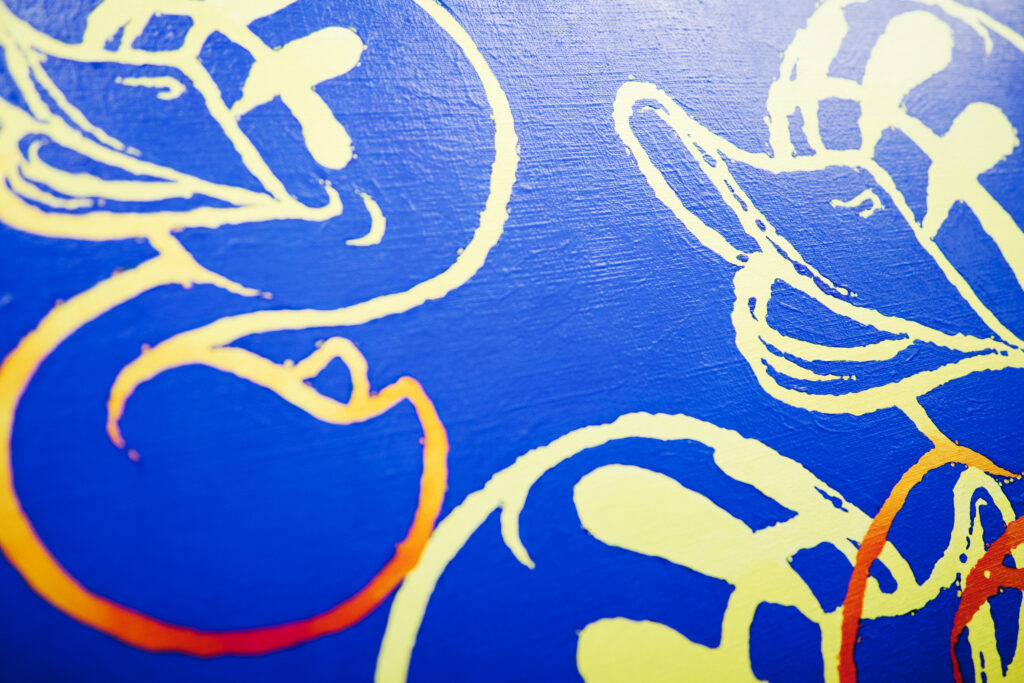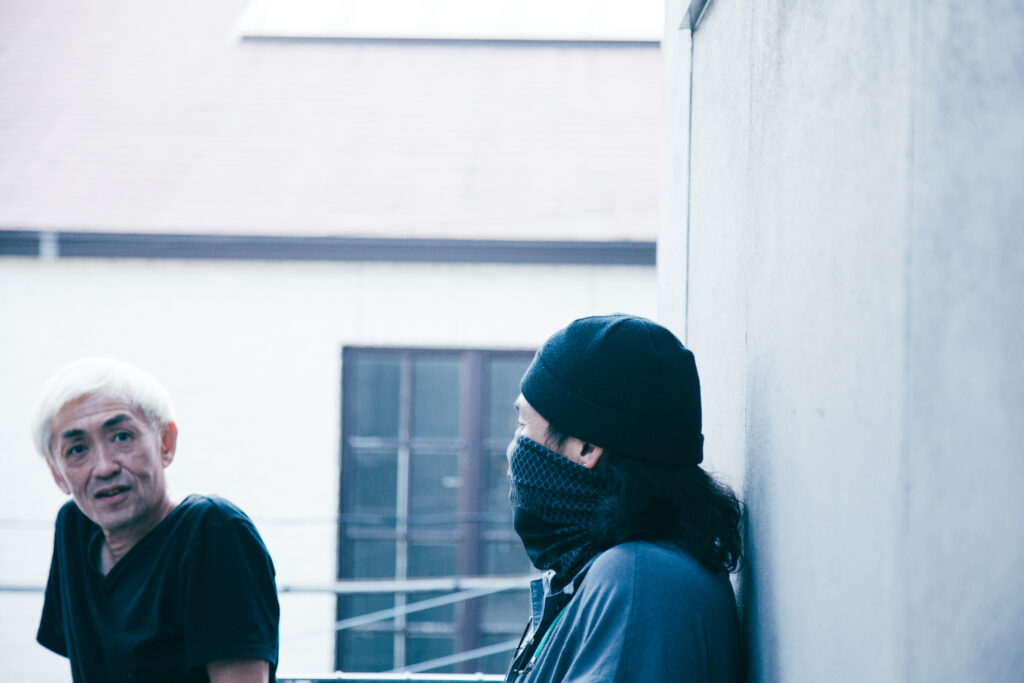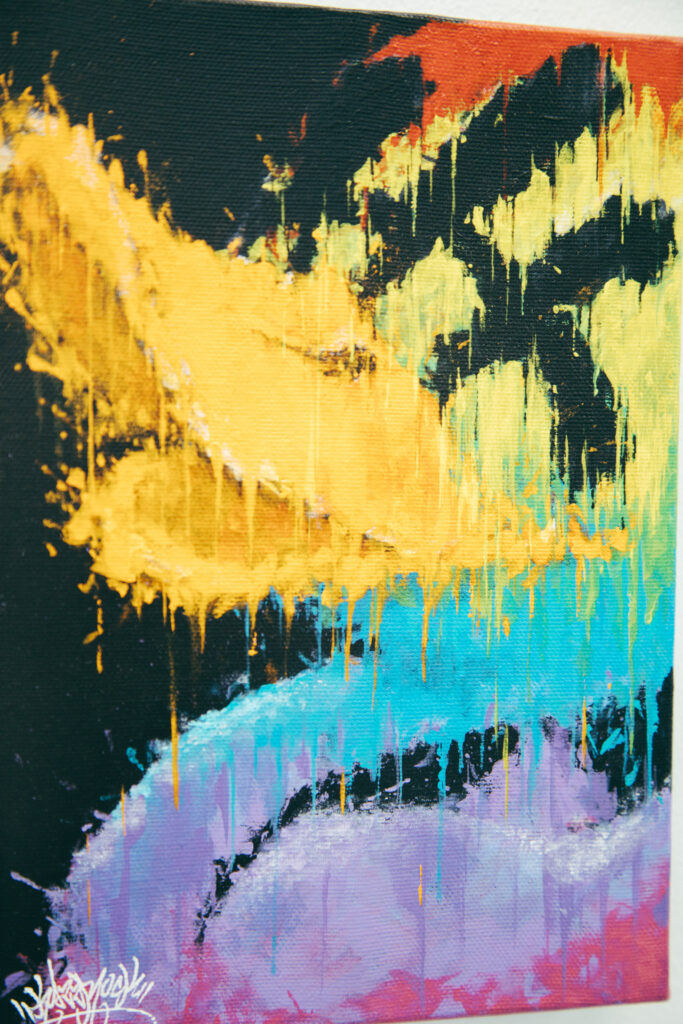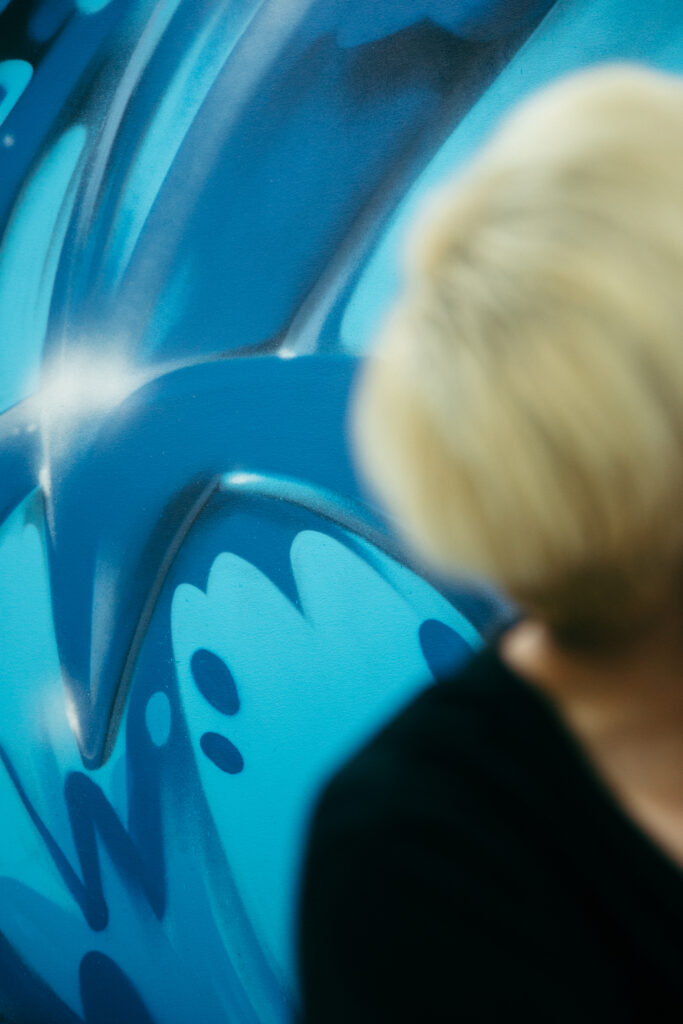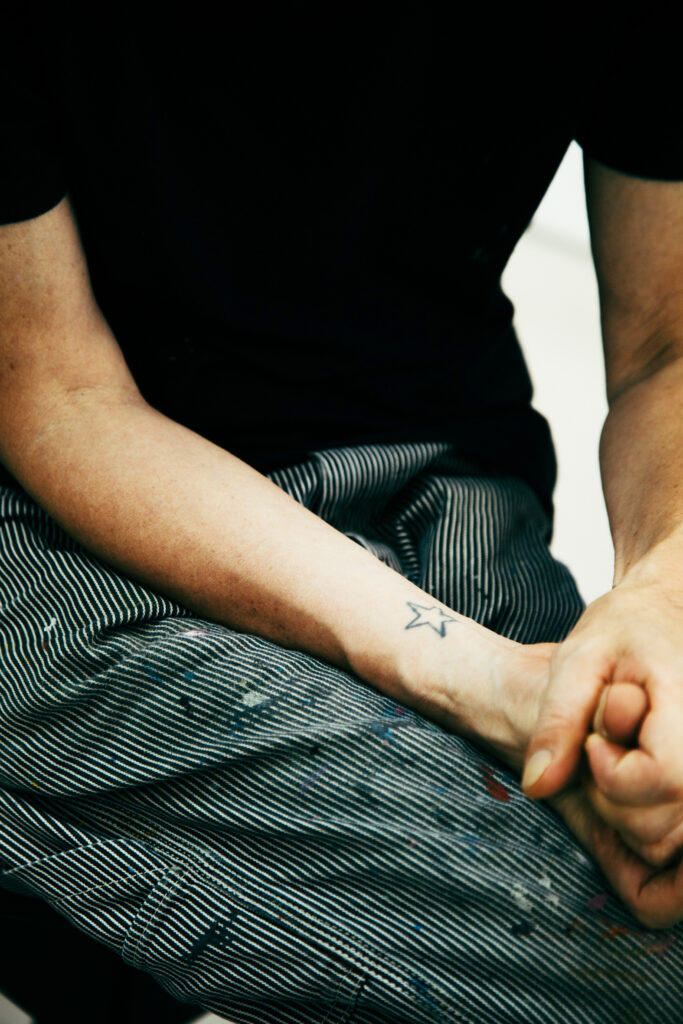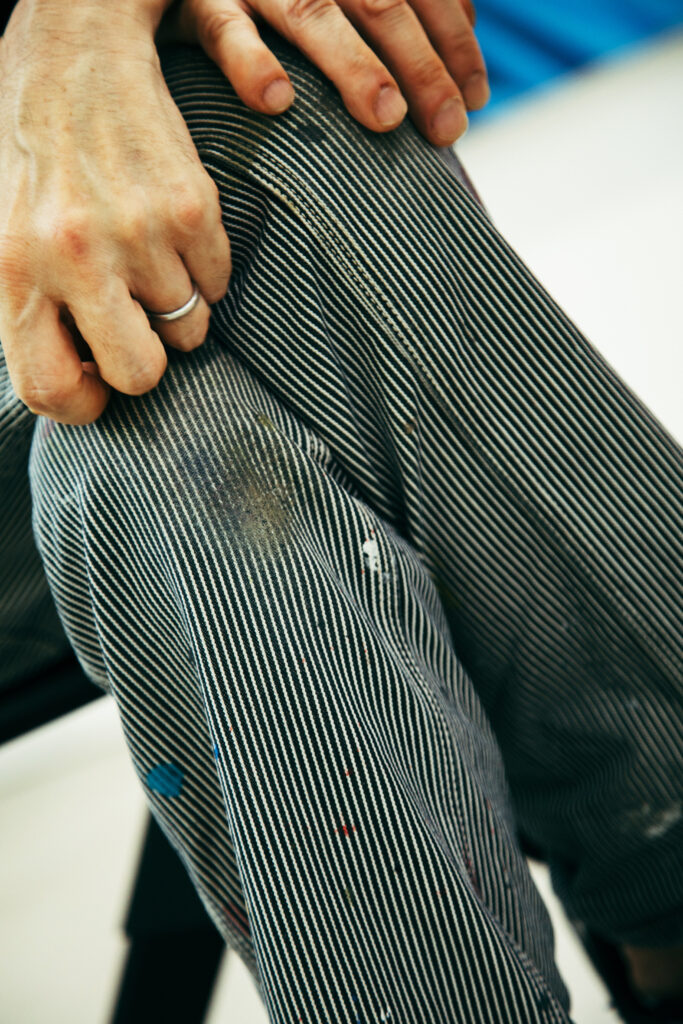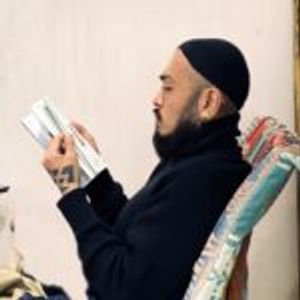holding solo exhibitions, designing CD jackets and artwork for major artists, and establishing an apparel brand. Today, he continues to create at the forefront of the scene. SNIPE1 is also a pioneer of the scene, and he too has been active since its early days. He moved to NY in the early ‘90s and spent about four years there, honing his skills on the street and fostering connections before returning to his home country. Recently, he’s grown his presence in the art scene, collaborating with artists such as Takashi Murakami and MADSAKI.
This is the second part of a conversation between the two artists, who have crossed numerous boundaries without ever stopping their creative process. Following the first part of the conversation where they talked about the Japanese scene in the early ‘90s and their respective experiences in the US, they exchanged thoughts on the street versus art and today’s scene.
On the boundary between art and the streets
──Although this exhibition was held at an art gallery, you both have been active on the streets from the start. I’d like to know what you two think about the boundary between the world of art and the street. SNIPE, since your first solo exhibition, METAVIRUS, in 2018, you’ve also been working in the contemporary art scene, including a collaboration with Takashi Murakami.
SNIPE1: I wasn’t originally interested in it at all. Doing graffiti was enough for me. Now, I just take advantage of the opportunities I’m given.
KAZZROCK: I don’t really think about whether it’s “street” or “art” in the first place. I’ve felt absolutely no resistance to it since doing a solo exhibition in ’95.
SNIPE1: A lot of graffiti writers who break into the art scene change their style, but what I like about you is that you just bring your street style to the art world. I respect that about you. I feel a bit let down by people like Twist and KAWS—because KAWS’s lettering is definitely much cooler.
KAZZROCK: KAWS’s rough lettering is really cool.
SNIPE1: Right, it’s really great. But now, he always makes things with characters, and I’m not sure about it.
KAZZROCK: I know what you mean (laughs)
SNIPE1: In that respect, you do a good job of branding yourself, and with your Duckle series, you brought it to the street before bringing it to galleries. I’m interested in how good you are at that. In fact, I think that might be the important part.
KAZZROCK: Well, for me, of course, there are differences like the time constraints and the feeling of doing it live when I’m painting on a wall versus a canvas. And with the canvas, it’s not an ephemeral thing like graffiti since someone is buying and preserving it. It’s not like I’m unaware of those things, but essentially, there isn’t a huge difference for me. To put it simply, I just love painting.
SNIPE1: I end up thinking a lot when I have to put something on a canvas. Like the concept and the meaning. A lot of the people who buy my paintings are foreigners, and they place a lot of importance on the description. So they ask stuff like, “Why is this motif here?” I have to be able to explain that properly.
KAZZROCK: Wow, that’s admirable of you. (laughs) I just say, “Look at it and feel it,” and that’s it.
SNIPE1: It’s really forced for me too, though. Like after I drew a chicken, I looked up folklore about chickens, so it was sort of an afterthought. (laughs) I really just wanted to draw a chicken.
KAZZROCK: Right. I’ve had people ask, “Why a duck?,” but I’m like, “I dunno.” I mean, I understand why people want to know, but they should think about it on their own.
SNIPE1: That’s really true. That’s why I recently painted a piece called, “Think about it before you ask me.” Descriptions are too much. But that being said, I do think about the message with graffiti. It’s my own propaganda. George Orwell said, “All art is propaganda.” Although he also said, “On the other hand, not all propaganda is art.” Especially when it’s illegal, the message comes across really strong. Banksy and Kidult’s messages really resonate, don’t they?
KAZZROCK: I don’t have any message at all. Mear always included some sort of message, but I don’t bring that kind of perspective to my expression. I think it should be more fun and natural. The way I think of it, I’d like my art to be open to more people rather than targeting someone with a political goal. But that doesn’t mean doing something commercial. I just like fun things. I don’t know about the future, though. This has been my style for 30 years, but maybe it’ll change.
SNIPE1: Everyone changes, after all.
KAZZROCK: I guess if you think about it, that’s true. And your work can change a lot depending on who you want to show it to.
SNIPE1: Oh, I know what you mean. These days, I also want to paint pictures that my kids would be happy to see. If you think about it, we only really used to care about what other writers thought.
KAZZROCK: Right, writers were only aware of each other.
SNIPE1: Graffiti is that kind of game, isn’t it?
The graffiti environment today & experiencing the real thing
──In that respect, one could say that today, that game has expanded quite a bit. While there’s been a rise in surveillance cameras and the situation in the city has changed, I also think the introduction of social media is huge. The act of looking at graffiti has become something completely different from before. Illegal graffiti and legal mural art are displayed side-by-side on our smartphone screens, making it difficult to distinguish between them. On the other hand, the audience has grown dramatically. What do you two think of this change in the graffiti environment?
SNIPE1: Well first, from the 1990s to about the early 2000s, graffiti was completely different depending on the city. Today, those borders have disappeared, and it’s impossible to say where a graffiti style is from. I mean, I don’t know. It’s no longer like—it’s New York, so the throw-ups look like this. It’s all mixed up. It’s the same with pieces, isn’t it? We’re no longer in an era where there are top writers in each city, and the younger kids are copying them. Today’s kids start by looking on social media. They see that someone has good style and they start painting something similar, so naturally, style has become more globalized, and in a way, it’s become more homogenized. I don’t know whether this is a good or bad thing, but at the very least, we lose the characteristics of each city. We talked about how I’m NY style, and KAZZ is LA style earlier, but we can’t talk like that anymore, can we?
KAZZROCK: That’s true. Since graffiti has become borderless, we can’t tell where a style originated from. If we look at it positively, I think it’s become easier to learn thanks to social media, and it’s totally acceptable to start from there. I guess this is happening not only in Japan but all over the world. Today’s generation has better tools and everyone’s skilled, but if you’re only skilled, people admire your work and that’s it. But if you have a strong sense of dedication to the work, that admiration becomes emotion. That’s why I’ve always painted without a rough draft. It’s true that it’s easier with a rough draft to draw perfect, precise lines. My lines might be slightly off, but it all adds up to become my work. That’s what style is all about, so in that sense, I talk to SNIPE all the time about how there’s something off about the recent stuff.
SNIPE1: I mean, they can’t help it because they’re young. But I think it’s an issue that they don’t and can’t see much of the real thing. There are a lot of kids who just look at pictures and draw, but the real thing is different from pictures. It’s much rougher. That’s where the charm lies. It’s not enough just to paint beautifully. It’s the same with a solo exhibition—it’s completely different from looking at a picture.
KAZZROCK: That’s very true. Especially with graffiti.
SNIPE1: Because graffiti isn’t just about the technical aspects, but the atmosphere or vibe of the place. A picture could never convey how scary it is to get to the end of a tunnel.
KAZZROCK: We had no choice but to go.
SNIPE1: But today’s Tokyo doesn’t have any places where you can see the real thing in the first place. That’s a huge issue. There are only bombers.
KAZZROCK: There are no masterpieces anywhere. It’s sad.
SNIPE1: If there were something like that, I think the situation in Tokyo would change, but there’s no place to begin with. Even small cities have a free wall (Hall of Fame). Tokyo doesn’t have that. I don’t think this is the time for the Olympics.
KAZZROCK: Maybe. But the hard part is, can you really paint with the feeling of the street if you’re told, “You can paint here”? There’s no thrill or excitement there. And that ends up coming out in your work.
SNIPE1: It does. There’s that “live” feeling precisely because you’re painting frantically. Still, I want at least one free wall. In the ‘90s, Sakuragicho and Yoyogi had them, right? There were a lot of people who saw that and started painting.
──A few years ago, everyone was talking about how Governor Koike took a commemorative photo with a Banksy piece at Hinode Pier. However, the reality is that Tokyo doesn’t have a single free wall. There’s something twisted about that, isn’t there?
SNIPE1: Right. But…it’s to be expected with Banksy. Because everyone knows that Banksy is valuable. At the time, some writers were saying stuff like: If it’s okay for Banksy to do graffiti, then I should be able to as well. But I thought—No, no that’s different. Because your paintings have no value. (laughs)
KAZZROCK: I agree with that. It’s like saying you want to play in the finals when you haven’t even won the regional qualifiers.
SNIPE1: Actually, Banksy is really cool. I respect him a lot.
KAZZROCK: He’s good at realism, and his stenciling is good too.
SNIPE1: He’s just really bad at lettering (laughs)
KAZZROCK: I know (laughs). So, that’s why he found what he’s good at. He used stencils, a method that’s been around for a while, and his wit. I think that’s enough.
SNIPE1: Yeah, he’s really witty. I always feel like I’ve been gotten. I don’t like the kind of writers who don’t like Banksy.
KAZZROCK: He’s an incredible creator. And even with KAWS, I said that thing earlier, but I really love him. At the end of the day, the people who are ahead of the others are the ones who put in the work.
SNIPE1: For sure (laughs)
KAZZROCK: People who can keep doing things like that are really amazing. You have to acknowledge people first. That’s why I try not to say this and that about people’s paintings. Basically, I like them.
SNIPE1: Right, right. Despite everything, graffiti writers can become friends because they share the same goal. We’ve really grown up, huh? (laughs)
*
KAZZROCK
KAZZROCK is a graffiti writer/artist from Tokyo. In the early ‘90s, he founded VANGUARD, an organization dedicated to various activities within the street scene, including graffiti and hip hop. Later, he moved by himself to the US to hone his skills and joined the Los Angeles graffiti crew CBS, becoming the only Japanese member. After returning to Japan, he continued with street art while also doing solo exhibitions, making CD jackets and artwork, and designing things for manufacturers. In 1998, he started his own apparel brand, KAZZROC ORIGINAL, and in the following year, he established his own company, VANGUARD. In 2005, he became the main sponsor of the All Japan Road Race Championship in the ST600 class, designing the racing suit and helmet under the name KAZZROCK RACING. In 2015, he had an exhibition in Hong Kong, and in 2019, he had exhibitions in Taiwan (in 10 locations including Taipei, Taichung, Tainan, and Kaohsiung). Today, he continues to be active in a variety of fields both at home and abroad.
Instagram:@kazzrock_cbs
Twitter:@kroriginal
SNIPE1
SNIPE1 is a graffiti writer and artist. As a teenager in the early ‘90s, he threw himself into the NY graffiti scene. After exploring the graffiti community across the world and creating connections, he returned to Japan. Since moving his base to Japan, he has contributed to the rise of graffiti culture in Japan in many ways. In 2018, he held his first solo exhibition at Takashi Murakami’s Hidari Zingaro gallery, winning acclaim. To this day, he’s still bombing the art world through avant-garde galleries around the world, including in LA, NY, Bangkok, Hong Kong, and Melbourne.
Instagram:@fukitalltokyo
Photography Ryosuke Kikuchi
Special Thanks HARUKAITO by island
Translation Aya Apton

